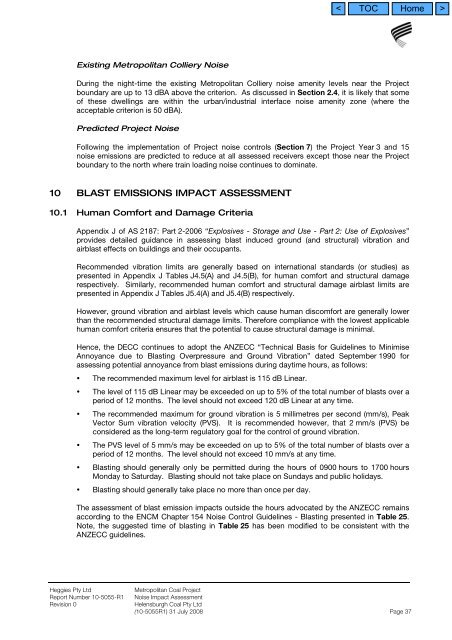Appendix J - Peabody Energy
Appendix J - Peabody Energy
Appendix J - Peabody Energy
Create successful ePaper yourself
Turn your PDF publications into a flip-book with our unique Google optimized e-Paper software.
Existing Metropolitan Colliery Noise<br />
During the night-time the existing Metropolitan Colliery noise amenity levels near the Project<br />
boundary are up to 13 dBA above the criterion. As discussed in Section 2.4, it is likely that some<br />
of these dwellings are within the urban/industrial interface noise amenity zone (where the<br />
acceptable criterion is 50 dBA).<br />
Predicted Project Noise<br />
Following the implementation of Project noise controls (Section 7) the Project Year 3 and 15<br />
noise emissions are predicted to reduce at all assessed receivers except those near the Project<br />
boundary to the north where train loading noise continues to dominate.<br />
10 BLAST EMISSIONS IMPACT ASSESSMENT<br />
10.1 Human Comfort and Damage Criteria<br />
<strong>Appendix</strong> J of AS 2187: Part 2-2006 “Explosives - Storage and Use - Part 2: Use of Explosives”<br />
provides detailed guidance in assessing blast induced ground (and structural) vibration and<br />
airblast effects on buildings and their occupants.<br />
Recommended vibration limits are generally based on international standards (or studies) as<br />
presented in <strong>Appendix</strong> J Tables J4.5(A) and J4.5(B), for human comfort and structural damage<br />
respectively. Similarly, recommended human comfort and structural damage airblast limits are<br />
presented in <strong>Appendix</strong> J Tables J5.4(A) and J5.4(B) respectively.<br />
However, ground vibration and airblast levels which cause human discomfort are generally lower<br />
than the recommended structural damage limits. Therefore compliance with the lowest applicable<br />
human comfort criteria ensures that the potential to cause structural damage is minimal.<br />
Hence, the DECC continues to adopt the ANZECC “Technical Basis for Guidelines to Minimise<br />
Annoyance due to Blasting Overpressure and Ground Vibration” dated September 1990 for<br />
assessing potential annoyance from blast emissions during daytime hours, as follows:<br />
• The recommended maximum level for airblast is 115 dB Linear.<br />
• The level of 115 dB Linear may be exceeded on up to 5% of the total number of blasts over a<br />
period of 12 months. The level should not exceed 120 dB Linear at any time.<br />
• The recommended maximum for ground vibration is 5 millimetres per second (mm/s), Peak<br />
Vector Sum vibration velocity (PVS). It is recommended however, that 2 mm/s (PVS) be<br />
considered as the long-term regulatory goal for the control of ground vibration.<br />
• The PVS level of 5 mm/s may be exceeded on up to 5% of the total number of blasts over a<br />
period of 12 months. The level should not exceed 10 mm/s at any time.<br />
• Blasting should generally only be permitted during the hours of 0900 hours to 1700 hours<br />
Monday to Saturday. Blasting should not take place on Sundays and public holidays.<br />
• Blasting should generally take place no more than once per day.<br />
The assessment of blast emission impacts outside the hours advocated by the ANZECC remains<br />
according to the ENCM Chapter 154 Noise Control Guidelines - Blasting presented in Table 25.<br />
Note, the suggested time of blasting in Table 25 has been modified to be consistent with the<br />
ANZECC guidelines.<br />
Heggies Pty Ltd<br />
Report Number 10-5055-R1<br />
Revision 0<br />
Metropolitan Coal Project<br />
Noise Impact Assessment<br />
Helensburgh Coal Pty Ltd<br />
(10-5055R1) 31 July 2008 Page 37

















